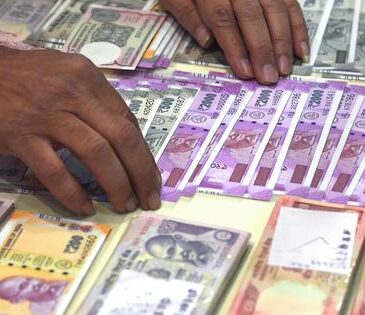
Summary of key points: –
- US Dollar higher on Powell super-caution and Trump’s nuclear testing
- Inflation shocker changes the dial for the Reserve Bank of Australia
- Comments from RBNZ Monetary Policy committeeman appear misplaced
US Dollar higher on Powell super-caution and Trump’s nuclear testing
Our expectations were that the two key events for global foreign exchange markets last week, the US Fed cutting interest rates at their meeting and the Donald Trump/Premier Xi Jinping trade summit meeting in Korea reducing trade tensions, would weaken the US dollar value.
However, to the contrary, the markets responded to unexpected outcomes from the two events by buying the US dollar against the major currencies. The USD Dixy Index appreciating from 98.40 a week ago to 99.56 at the New York Friday market close. The factors that caused the buying of the US dollar being: –
- Whilst the Fed duly delivered the expected 0.25% cut to the Fed Funds interest rate, the accompanying message from Fed Chair Jerome Powell was not expected. He stated “a further reduction in the policy rate at the December meeting is not a forgone conclusion. Far from it”. The markets were expecting a confirmation from the Fed of their pricing of another cut in December, the surprise was that Powell almost ruled this out.
- The day before the scheduled Trump/Xi Jinping trade meeting, the Donald surprised everyone with a statement that the US would recommence testing of nuclear arms, as other countries were doing that. That statement dramatically increased global political risk (USD positive) precisely at a time when the expectation was that the relationship between the US and China was on the improve from the trade summit meeting.
The question before the currency markets from here is whether these two outcomes are merely short-term market reactions to unexpected developments, or something more fundamental and permanent in terms of the US dollar value and direction. We would still favour the former, as the underlying conditions and trends in the US economy remain on the soft side that justify further interest rate cuts from the Fed on the employment side of their dual mandate.
Unfortunately, both the Fed and the markets have been “flying blind” to a certain degree, as there are no official statistics on the US economy from Government agencies due the Federal Government shutdown over the last month. The Fed continue to be seriously divided on the outlook for inflation, employment and the economy generally. To have two voting members formally dissenting from the decision to cut by 0.25% (one wanted a 0.50% cut, the other “no cut”) provides evidence to Chair Powell that he has no idea how his FOMC committee will vote at the next meeting six weeks away on December 10th.
What information on the state of the US economy that is becoming available to the FX markets is (in our view) far from being so positive that it would cause the Fed to pause on another interest rate cut in December. Consider the following developments: –
- Services inflation is reducing sufficiently to almost offset the increase in prices from imported goods due to tariffs. The Fed seems more convinced that the tariff impact on inflation is a “one-off” and not causing additional price increases.
- Consumer confidence continues its decline to record low levels. Discretionary spending for the middle- and low-income groups is in decline. If retail sales data was available, it would be printing on the soft side.
- Concerns about hidden risks in the US private credit lending markets are certainly increasing. There is not a lot of information available on the activities of the non-bank financial institutions (NBFI’s). JP Morgan boss, Jamie Dimon has warned of “cockroaches” in the financial system. However, Fed Chair Powell said that the Fed is “paying close attention” to recent cracks in the subprime auto loan market, but it does not yet view that deterioration as a” broader credit issue”. The Fed may well be found out here as too complacent on these emerging financial risks.
- Many large companies in the US in technology, retail and manufacturing are signalling a freeze on new job hiring or layoffs as AI automation is causing workforce restructuring: –
- Amazon – 14,000 jobs cut
- UPS – 48,000 jobs cut in 2025
- Target – Elimination of 1,800 corporate positions.
- Microsoft – 15,000 jobs cut in 2025
- General Motors – laid-off 1,700 manufacturing workers
- Proctor & Gamble – cut 7,000 jobs over two years
Trump is using the shutdown to decrease many Government jobs permanently, so when we finally do receive the Non-Farm Payrolls jobs data for the months of September and October, the numbers are unlikely to be that flash.
It will certainly be interesting for both US interest rate and foreign exchange markets when the Government budget impasse is resolved, and the shutdown comes to an end. The markets will be bombarded with a ton of data all at once to interpret and react to.
This latest bout of US dollar strength is likely to be as short-lived as all the previous upticks in the USD Index since the start of 2025. In the end, it is the economic direction that counts (along with interest rate movements relative to other currencies), in determining the medium-term fortunes of the US dollar. History tells us that the USD sideways movement over recent months will come to an end.

The remarkable mirror pattern of eight year’s ago under Trump’s first term as President continues for the US dollar (refer to the chart above). Another significant leg down in the US dollar value seems likely over coming months as history repeats, with the economic fundamentals backing that direction up.
The recent USD gains have sent the NZD/USD exchange rate back to the lows 0f 0.5725 from the 0.5800 level. In the lead-up to Christmas, it is hard to see local NZ factors influencing the NZD/USD rate, so we are back to tracking the US dollar again.
Inflation shocker changes the dial for the Reserve Bank of Australia
“Egg on face” all round for both the economic forecasters and the Reserve Bank of Australia (“RBA”) last week as Australian inflation jumped up much higher, well above all expectations. The RBA forecast for the inflation increase over the September quarter was +0.60%, the actual result came in at more than double that figure at+1.30% (the annual headline rate of inflation zooming up from 2.10% to June 2025 to 3.20% to September 2025). Price increases were across the board, particularly electricity, rates, alcohol, food and healthcare (very similar to New Zealand at this time).
Market interest rates shot up to price-out earlier expectations of further interest rate cuts. The Australian two-year Government Bond yield increasing from 3.42% before the CPI inflation release, to a high of 3.62% on the day on Wednesday 29th October. Their OCR interest rate is at 3.65% and is now unlikely to change for some time as the RBA reassess their forecasts of inflation and the economy. It seems that Australia may now be paying the price for not tightening monetary policy as hard as NZ and the US in 2023. As a consequence of not sufficiently slowing down the economy, inflationary pressures have remained and today their inflation tracks higher than other countries.
Australian’s higher inflation track now creates a paradigm shift in the interest rate differential to the US. Over the last three years the Australian dollar has been out of favour with global currency investors as its interest rates remained 1.00% below those of the US. Currency traders preferred to hold “short-sold” AUD positions against the USD as they were well ahead on the forward points earned without the spot rate going in their favour. That situation has now changed to a zero-interest rate differential with US interest rates decreasing and Australian rates stable to higher. It is a major and fundamental change to the relationship between the AUD and the USD. The previous barrier to buying and holding the Aussie dollar has now been removed.
The AUD/USD exchange rate lifted to 0.6615 following the inflation release, however subsequent global events with the US dollar (Fed caution and Trump’s nuclear arms comments) has pulled the Aussie dollar back to 0.6550.
How quickly the Australian dollar can achieve the majority of new forecasts to 0.7000 and above against the USD over coming months depends on two conditions playing out: –
- Chinese economic data improving. Of late, outside of exports, the Chinese economic data has been sideways and disappointing. How the Chinese government authorities can convince the masses that is now safe to spend and not save is a vexed question. The Aussie dollar is a proxy for all things China, so Chinese economic data needs to improve if the AUD is to make the expected gains.
- US economic date being weaker that allows the Fed to cut their interest rates again on 10th December. ISM Manufacturing PMI’s this Tuesday for the month of October are forecast to be stable, as are the Service PMI two days later. The US markets are now using less reliable high frequency private survey data as a gauge of the economic directions. Further deterioration in jobs and credit conditions are both likely occurring in the US; however, we just do not have the data to support that view.
The RBA’s monetary policy meeting on Melbourne Cup Day, Tuesday 4th November now takes on an entirely new dimension. The “no change” to interest rates will most likely be accompanied with a more hawkish tone from RBA Governor, Michelle Bullock as she realises that they have much more to do to get inflation under control. The response trajectory for the Aussie dollar can only be upwards.
Comments from RBNZ Monetary Policy committeeman appear misplaced
The Kiwi dollar was sent back to its recent lows of 0.5725 last week by a stronger US dollar for the reasons discussed above. The NZD/USD rate pulling back 75 pips from 0.5800 as the AUD/USD exchange rate depreciated from above 0.6600 to 0.6550.
Adding to the downward pressure on the Kiwi dollar were comments from an unexpected source.
RBNZ Monetary Policy Committee member, Dr Prasanna Gai speaking in Melbourne, was reported as assessing the US tariffs as a “negative demand shock” for New Zealand and that they are acting as headwinds to an already restrained economic growth. He affirmed that these shocks, coupled with high global uncertainty, have offset some of the central bank’s monetary easing cycle, strengthening the case for further interest rate cuts in the near term.
Our analysis of what has caused demand in the NZ economy to remain very subdued through the winter months of 2025 was the fact that households who were paying less in mortgage interest costs were using the extra money to reduce high debt levels and not spend it in the retail stores. The high debt levels were essentially encouraged by the super cheap interest rates the RBNZ implemented in 2021 and 2022. Instead of blaming external factors for causing the delay in the transmission mechanism from lower interest rates to stimulated to economic demand, Dr Gai should look a little closer to home!
New Zealand’s dairy, beef and sheep meat exporters have not missed a beat, despite the 15% US import tariffs. Demand and prices for their export products remains high. Our wine export industry is not happy with the US tariffs as it comes at a time when excess supply is already forcing prices downwards. However, NZ wine exports to the US are a tiny part of our economy.
Let’s hope there is a more balanced debate at the next RBNZ Monetary Policy Committee meeting on 25th November as to what has caused the delay in the economic response to the 300 basis points of interest rate cuts (5.50% to 2.50%) since August 2024. Cutting interest rates further to 2.00% would depreciate the NZ dollar further, which in turn increases tradable inflation at a time when the annual inflation rate is already above the 3.00% upper limit. The RBNZ need to be careful here that they do not allow the impatience of various economic forecasters for a pickup in the housing sector/economy to cause them to be too impatient.
A casual glance across the Tasman Sea as to what is causing Australia’s sticky/high inflation would be in order for the RBNZ as well.
chart:daily exchange rates]
*Roger J Kerr is Executive Chairman of Barrington Treasury Services NZ Limited. He has written commentaries on the NZ dollar since 1981.




